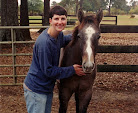I took a workshop in Masterson Method
bodywork for horses last weekend, and there was SO MUCH GOOD. For one thing, it
was a privilege to work with the Thoroughbreds we learned with, who were so
willing and who showed so much improvement in their musculature and their
relaxation after just one day. It felt great to be doing that kind of good for
horses in need of it.
But by far the most good done was the good
done to me.
The Masterson Method can have the positive
effect that it does, I believe, because it creates a space where there is no
wrong.
The horse can do no wrong because everything
he does is just part of his process of moving from defending himself to letting
go. Whether he chews on things or fidgets and moves around or seems to be
completely ignoring you, all of that truly is just information by which you get
an idea of where he is in the process of letting go—not a behavior that needs
correcting.
And the human can do no wrong because the
Masterson Method can only do good for the horse. Even if you’re only “in the
neighborhood” of where you’re supposed to be, you can help the horse release.
Even if you don’t wait for the release, you’ve helped the horse to start
processing. Even if you can’t do all the techniques perfectly, you can do a
great deal of good.
This is a radically freeing space in which
to exist. By contrast, how often do we feel that we are screwing things up or
aren’t good enough to perform in some way? That we don’t know enough, don’t have
the skills or the discernment? And how often does the need to be and do things
right leave us isolated in our own heads instead of connecting with others?
The amazingly cool result of being in the
space of doing no wrong is that you can listen phenomenally well. When your
ego-driven need to do things right isn’t running the show, you can suddenly
hear all sorts of things your horse is telling you. And the amazingly cool
result of THAT is you find yourself truly working with the horse.
In fact, that’s what the Masterson Method
is: a process the horse and human go through together, each guiding the other
in an endless back and forth of offering and receiving suggestions. It
absolutely defines doing things *with* the horse.
Of course many of the people I’ve studied
with have emphasized the need to do things with and for the horse rather than
to or at him. And I’ve agreed every time. But actually living in that space has
been hard for me to do. I may in general have a goal of, say, helping my horse
overcome his fear, but when I ask him to do things to build his confidence, I
find myself stuck in my own agenda of asking him to confront his fears instead
of in a conversation with him about how best I can help him feel better.
So my experience last weekend was almost
wholly novel to me. I saw that the horses were just where they were, doing the
best they could to manage in the lives they’d been handed. I saw that they were
going to struggle some with the process of letting go of their defenses just as
I was going to struggle some with the process of learning how to help them do
that. And I saw how willing they were to go through the process with me despite
all of that.
All of this made me feel great compassion
for everyone, animal and human and myself included, who has built defensive
patterns to keep themselves safe and yet yearns to let go of those patterns. As
our instructor said, a horse saying, “No, no, no, no,” is really saying, “Help me,
help me, help me!” True for horses, true for people.
And in this context, worrying about doing it
right just doesn’t even factor in.




No comments:
Post a Comment